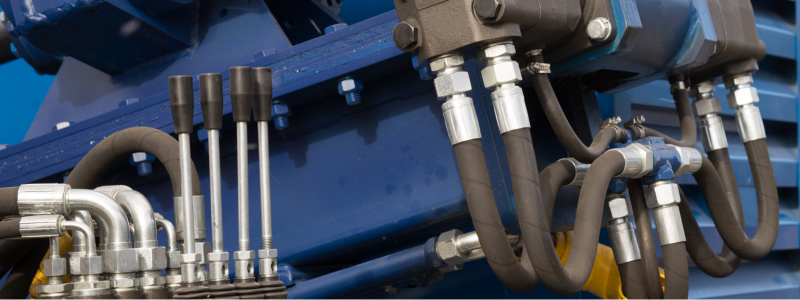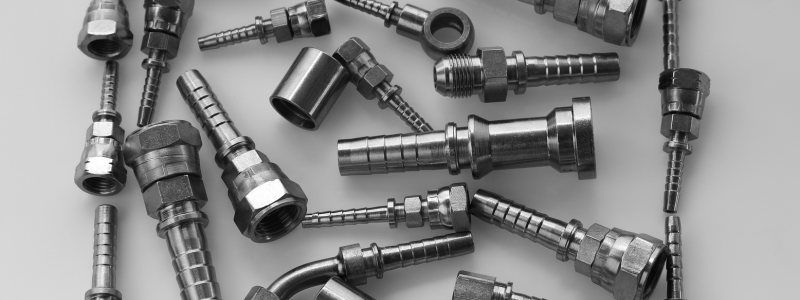The Ultimate Guide to Hydraulic Hose Fittings: Everything You Need to Know
Understanding Hydraulic Hose Fittings
Hydraulic hose fittings are used to connect hydraulic hoses to various components such as pumps, valves, cylinders, and other hydraulic systems. They provide a secure and leak-proof connection, ensuring the proper flow of hydraulic fluid under high pressure.
These fittings are essential in maintaining the efficiency and reliability of hydraulic systems, allowing for the transmission of fluid power in machinery used in industries like construction, agriculture, manufacturing, and transportation. They also help in adapting different thread types, hose sizes, and connection angles for diverse applications.

How do I choose the right hydraulic hose fitting?
To choose the right fitting, you need to consider:
- Thread type (e.g., BSP, BSPT, NPT, NPTF, JIC, JIS, SAE, ORFS).
- Hose size (e.g., 1/4", 3/8").
- Pressure rating: Ensure the fitting can handle the system’s pressure.
- Material: Steel, stainless steel, or brass depending on the environment.
What common types of hydraulic hose fittings are available?
Hydraulic fittings are found across nearly every industry, with a wide variety of uses and applications. Different types of fittings are designed for different applications and specifications
- Straight fittings: For direct, in-line connections.
- Elbow fittings (e.g., 45° and 90°): For directional changes in hoses.
- Swivel fittings: Allow movement and rotation without disconnecting.
- Compact fittings, Designed for use in tight spaces
- Banjo fittings: For tight spaces where standard fittings won’t fit.

What are the most common thread types for hydraulic hose fittings?
Some of the common thread types include:
- BSP (British Standard Pipe): Used primarily in the UK and Europe. BSPP (Parallel): This type of thread has parallel sides and is sealed using an O-ring or bonded washer. BSPT (Tapered): The threads are tapered, and the seal is created by the thread deformation as the connection is tightened.
- JIC (Joint Industry Council): Widely used in the US. This fitting has a 37° flared sealing surface, providing a metal-to-metal seal.
- NPT (National Pipe Tapered): Also common in the US. Tapered thread profile with the seal created by the thread deformation.
- Metric threads: DIN 7631 and DIN 7643: Metric threads are typically used in hydraulic fittings throughout Europe. Common in many global applications.
What is the difference between hydraulic hose fittings and adaptors?
Hydraulic hose fittings are designed to connect hoses to components, while adaptors are used to connect two different thread types or fitting sizes. Adaptors modify the connection without replacing an entire fitting.
Steps on how to Measure a Hydraulic Fitting
Measuring a hydraulic hose fitting accurately is essential to ensure proper compatibility and prevent leaks in hydraulic systems. Here’s how you can measure a hydraulic hose fitting:
1. Identify the Thread Type
- Measure Thread Diameter: Use callipers or a thread gauge to measure the outside diameter (OD) of the male thread or the inside diameter (ID) of the female thread.
- For male threads, measure the OD of the thread.
- For female threads, measure the ID across the opening.
- Count the Thread Pitch: Measure the distance between threads or count the number of threads over a certain distance to determine the pitch. Use a thread pitch gauge for accuracy.
- Determine the Thread Type: Common thread types include BSP (British Standard Pipe), NPT (National Pipe Tapered), JIC (Joint Industry Council), and Metric threads. Each has a specific thread angle and measurement standard.
2. Measure the Hose ID (Internal Diameter)
- Remove the Fitting: If possible, remove the fitting from the hose.
- Measure the Hose’s Internal Diameter: Use callipers to measure the inside diameter of the hose where the fitting attaches. The size of the hose fitting should correspond to the hose’s internal diameter.
3. Determine the Fitting Style
- Identify the Fitting End: Look at the fitting’s connection ends (Male or Female). These could be straight, 45°, or 90° elbows, or other specialized shapes like T-shaped or swivel joints.
- Common Fitting Styles: Elbow, straight, tee, cross, and swivel fittings are common styles, and their angles (if applicable) should be measured or identified.
4. Measure the Seat Angle (for Tapered Threads or Sealed Joints)
- Find the Seat Angle: Certain hydraulic fittings have a seat angle that contributes to the seal. For example, JIC fittings have a 37° seat, while SAE fittings have a 45° seat.
- Use a Seat Angle Gauge: Measure the angle of the sealing surface using a gauge to ensure correct fitting type.
5. Measure the Overall Length of the Fitting
- Measure from End to End: Use callipers or a ruler to measure the fitting's overall length, from one end of the fitting to the other.
6. Check the Fitting Orientation
- Elbow Fittings: If the fitting is bent, measure the angle (e.g., 45° or 90°).
- Orientation: For swivel fittings or elbows, note the direction the fitting faces relative to the hose to ensure a proper connection.
7. Identify the Material
- Material Type: Hydraulic hose fittings come in different materials like steel, stainless steel, brass, and aluminium. Identifying the material can help match the fitting to the right application and prevent corrosion or wear issues.
Tools You Might Need:
- Callipers or a ruler (for measuring diameter and length)
- Thread pitch gauge (for measuring thread pitch)
- Seat angle gauge (for determining seat angles)
- Vernier calliper (for internal and external diameters)
Measuring Example:
Let’s say you have a male hydraulic fitting and need to measure it:
- Measure the thread diameter with callipers. If it’s 9.52 mm (3/8 inch), it’s likely a 3/8" fitting. This is based on most thread types other than BSP Thread which is based on the internal bore of the pipe. The major diameter for 3/8" BSP for example is 16.662mm.
- Count the number of threads per inch (TPI) or use a pitch gauge.
- Identify the thread type (e.g., BSP, JIC, or NPT) based on these measurements.
- Use a thread chart to compare your findings.
What's the difference between Crimp On Hydraulic and Reusable Fittings
Crimp-on fittings are permanently attached to the hydraulic hose using a crimping machine that compresses the fitting onto the hose.
Reusable fittings are designed to be installed and removed multiple times without damaging the hose or fitting.
Summary of Differences
Feature |
Crimp-On Fittings |
Reusable Fittings |
Connection Type |
Permanent |
Temporary |
Installation Requirement |
Requires crimping machine |
Manual installation, no special tools |
Reliability |
Strong, leak-proof connection |
Reliable, but can leak if not reinstalled properly |
Flexibility |
Less flexible; permanent application |
Highly flexible; can be adjusted easily |
Maintenance |
Entire assembly must be replaced if damaged |
Can replace fittings without replacing the hose |
Cost |
Potentially higher due to crimping |
Often more cost-effective for frequent changes |
Can I mix and match different brands of hydraulic hose fittings?
It's not recommended to mix and match different brands unless they meet the same standards (such as ISO or SAE) because slight variations in dimensions can cause leaks or improper connections.
What happens if I use the wrong hydraulic hose fitting?
Using the wrong fitting can lead to leaks, fitting failure, reduced system efficiency, or even a catastrophic breakdown of the hydraulic system. It's essential to use the correct fitting to match your system’s requirements.
How often should hydraulic hose fittings be inspected?
It’s recommended to inspect hydraulic hose fittings regularly, especially in high-use or high-pressure systems, for signs of wear, corrosion, or damage. Scheduled maintenance should include checking fittings to prevent failures.
Flowfit's Exceptional Hydraulic System Components and Accessories
Flowfit is dedicated to providing the finest hydraulic system components and accessories that are unparalleled in the market. If you're struggling to determine your needs or require assistance in locating a specific product, our Technical Sales team is always available to assist you. Our team is highly experienced and can provide expert guidance on the best products available.
Flowfit can complete any custom hose assembly to your exact specifications. We can help you design and build a safe and efficient hydraulic system that best meets your needs.
Contact us today to speak with one of our hydraulic specialists and explore your options. You can also shop for hydraulic hose fittings and products directly through our website.
The total one-stop supplier for hydraulic components & systems
Get in touch
Parys Road
Ludlow
Shropshire
SY8 1XY








